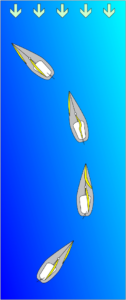Customer journey mapping can be a powerful tool to help you truly understand your customers, innovate around new ways to serve them, and identify gaps in their journey.
But, that’s only if the map is used as a tool and not an artifact.
Many CX teams spend months on a journey map only to have a beautiful poster on the wall that only tells part of the story.
Now, I love a beautiful poster as much as the next gal, but I’m here to tell you that you can’t master journey mapping by slapping a poster on your wall… no matter how good it looks.
Crucially, when we treat our Journey Map as an artifact, it can be counterproductive: When leaders witness how a lot of hard work resulted in a well-designed artifact which hasn’t served much of a purpose, it becomes easy for them to write off Journey Mapping as more of a diversion than a critical component of their success.
And yet, 86% of senior-level marketers believe it’s very important to create a cohesive customer journey.

By ThoKay, CC BY-SA 3.0
Creating a journey without a map is like sailing on the ocean. If we set a direction and forget it, we’ll soon find ourselves sitting motionless in the water.
Successful sailors use a method called tacking — consistently adjusting and maneuvering to build and keep momentum.
If you’ve embarked on a journey mapping initiative, are you sitting back and hoping the wind will take you where you want to go… or are you “tacking” by assessing where you are, where the wind is blowing, and asking what’s next?
Today I’ll share some ideas for ways to use your customer journey map to get you moving today and keep you moving tomorrow.
Most leaders today require data to make decisions. But that data is often still locked up in siloes or not translated into meaningful information about the customer.
Sharing your customer’s real journey helps leaders across your organization see beyond their own departmental roles and responsibilities.
Presenting the very idea of journey mapping can spur a better understanding of how important it is to see things from the customer’s perspective. Encourage others to use journey mapping techniques to uncover gaps in the processes and services offered to customers.
Your map will help others learn, which will only help your customers in the long run.
A great journey map tells you more than just what happened when. It highlights the moments that may make or break the journey for your customers.
Identifying those great moments that lead to more loyalty, more purchases or more positive word-of-mouth marketing means an opportunity to create more of them!
Take a closer look at why those moments matter and what makes them successful. That may be the way something was executed or simply the way a touchpoint made a customer feel.
Now, look for ways to pull those successful ideas to other parts of your journey.
You can also amplify those results by turning a “7” moment into a “10” moment with a little intention and innovation.
The flip side of the positive moments are the ones that disappoint.
Once you’ve found moments of customer disappointment in your journey mapping process, what will you do about them?
Once those negative moments are found, it’s time to roll up your sleeves and start considering ways to fix them. In some cases, more research may be needed, or pilots can be rolled out.
Create an action plan and take care of them. Experiment and learn. That’s where real innovation happens and when challenges can become opportunities to serve your customers better!
Journey Mapping should be an ongoing part of doing business. After all, we don’t say “we did marketing once, so we’re good for a while.”
Just like marketing, or budgeting, or delivering our products, we need to see mapping as an ongoing part of business.
The best organizations don’t check this off their list. They turn the journey map into a working tool used throughout their organizations.
Gathering a cross-functional team of customer champions who are dedicated to seeing these changes through is a great place to start. Ask your champions to help shepherd specific projects to completion and update the map again.
Then share what you’ve learned all over again!
You’ve heard the expression that it’s about the journey, not the destination. That cliché applies to journey mapping, too.
Is your journey map ready to become a tool, or is it just a relic?
Plan ahead and you can give your journey map the attention it deserves.
That, in turn, gives your customers the attention they deserve, too.
A version of this article initially appeared as The “What’s Next” of Journey Mapping on Intouch Insight.
 Jeannie is an award-winning customer experience expert, international keynote speaker, and sought-after business coach who is trailblazing the movement from “Reactive Customer Service” to “Proactive Customer and Employee Experience.” More than 500,000 people have learned from her CX courses on LinkedIn Learning, and her insights have been featured in Forbes, The Chicago Tribune, The Wall Street Journal and NPR.
Get Jeannie’s insights in your inbox each week by subscribing to The Weekly Win and follow her on LinkedIn, Instagram and YouTube.
Jeannie is an award-winning customer experience expert, international keynote speaker, and sought-after business coach who is trailblazing the movement from “Reactive Customer Service” to “Proactive Customer and Employee Experience.” More than 500,000 people have learned from her CX courses on LinkedIn Learning, and her insights have been featured in Forbes, The Chicago Tribune, The Wall Street Journal and NPR.
Get Jeannie’s insights in your inbox each week by subscribing to The Weekly Win and follow her on LinkedIn, Instagram and YouTube.